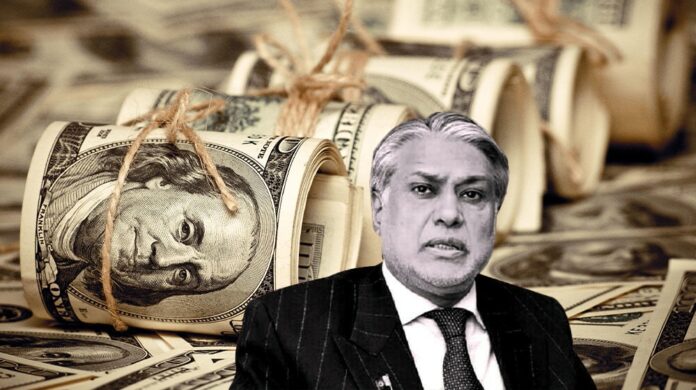Nestled in an alternate reality of appreciation, pegged to the hopes of going below the 200-rupee mark against the dollar, not even the rupee knew what was about to hit it on the morning of January 23. The State Bank of Pakistan (SBP) had come to office and had casually decided to send a team to conduct mystery shopping at the exchange company outlets.
Now why did the SBP feel the need to do so? Maybe a little bird told the bank that the companies were not being diligent. Ever since the dollar was under a peg, some of the exchange companies’ outlets had indulged in malpractice of hoarding and shorting of the dollar. After having placed a cap on the price of the dollars, some of these outlets were not only refusing to sell at said price, but were also selling it at a 20-30 rupee surcharge. The excess profit was of course, off the books. Let’s first understand how this situation was made possible. And how did this lead to a 12% depreciation within two days.
Some recap on the dollar:
The fact that there was the opportunity for an arbitrage left in the dollar market leaves many confused. To understand that we need to understand the exchange rate. It is now an open secret that the SBP exchange rate was understated as compared to the market value. In a meeting with the CEOs and exchange company heads, on October 30, 2022, Finance Minister Ishaq Dar assured the media that the price of the dollar against the rupee would be brought below the 200-rupee mark.
The meeting was held at the SBP. The representatives who attended that meeting were specifically reported for stating that the FM was “soft on the exchange companies”. Anyhow, ever since that meeting, these companies have followed a dollar-cap. This cap essentially means that the dollar would stay in a close vicinity of the interbank exchange rate. However, talking to Profit on January 24, Chairman Exchange Companies Association of Pakistan (ECAP), Malik Bostan stated that the government or the SBP did not set the rate for exchange companies; the ECAP decided to put a dollar cap on its own accord.
As a result of this cap, there are three prices for the dollar in the market. The SBP’s interbank exchange rate, the exchange companies’ rate (the open market rate) and the actual market rate, which in these particular circumstances is also called the “black market rate” – because the actual market rate, at this point, became open to guesses. The interbank rate hovered around 220-230 rupees/USD. The exchange companies were buying and (hardly) selling within 10 rupees of the interbank rate.
As per the publishing editor of Profit and a senior analyst, Babar Nizami’s calculations, the real market rate of the dollar was at the 250 mark by the end of December. These calculations are based on the rupee’s value against any other un-pegged, free floating currency (in this case the GBP), and reconciling that value in dollars with that currency’s own exchange rate against the dollar. Right now, this method yields the rate of the US dollar close to 260 PKR, considering the GBP was traded upwards of 320 at the market’s closing on Friday.
In the background, the country’s foreign reserves were depleting on a linear basis and the SBP, through its “administrative measures” was controlling the provision of dollars to banks and importers. Not only does this provide all the sellers a perfect reason for not selling dollars but it also creates higher demand in the market.
This higher demand is not just because of the transaction demand. The dollar now becomes a store of value, making it, as former finance minister Miftah Ismail calls it, “a one way bet”. Anticipating a sure-shot depreciation of the rupee, people start to buy dollars and much like the former example, “dealers” erupt in every nook and cranny, looking to make pennies on the dollar. This increases the demand incrementally, creating ample room for the practice of Hawala and Hundi, which the state has no control over. This went on for a few months, remittances fell, export proceeds failed to make it back to the country in the quantity that they should have but the peg on the currency prevailed. Up until January 23.
The mystery of mystery shopping:
On the morning of the 23rd, a team of the SBP caught 11 outlets of eight exchange companies for hoarding dollars. Mystery shopping is essentially a covert mission in which SBP officials dressed as common citizens go to these outlets and ask for dollars after ensuring they have dollars. If they still refuse to sell, the outlets are found guilty of hoarding.
The very next day, the ECAP announced that they would remove the dollar cap. The step was taken in the greater interest of the country, as has always been the foremost business priority of exchange companies. The Secretary ECAP, Zafar Paracha told Profit that it was a mere coincidence that the decision to take off the dollar cap was announced after the closing down of branches. After announcing this the ECAP had to meet the SBP deputy governor, in the morning.
The next day, however, the exchange companies after removing the cap for a couple of hours, went back to trading at the capped rate. The only variable that changed within the two hours was the meeting with the deputy governor, however, upon enquiry, Paracha said that the subject of dollar-cap was not even discussed in the meeting. The magnitude of this claim is remarkable considering the circumstances under which the meeting was called.
Hence, the ECAP episode could only be construed as a retaliation against the SBP. But what followed the next morning, surprised the entire country including the ECAP.
Ripping the band-aid off at the tipping point
Within hours of trade on Thursday, the dollar rate touched its all time high at 255. Come Friday the rate went up to 262, marking the highest ever devaluation in the last two decades in two consecutive sessions. The day also marked the announcement of Pakistan’s lowest ever reserves in the last nine years. At $ 3.67 billion and debt repayments in front, Pakistan did what it should have done a long time ago. The announcement was ever so quickly followed by the IMF’s confirmation of sending their team to Pakistan for talks on the 9th review of the IMF EFF.
The SBP had done what it had held off from doing for the last three months. Ripped off the Dar-peg band aid, but only when push came to shove. And Dar’s entire reason for taking over the finance ministry from Ismail, collapsed in front of the nation.
Dar still has in front of him, however, the process of negotiations once the IMF team arrives. A job that he has a 25-year experience in, according to him. It’s time for the country to see how stern is his eye contact, which is, yet again, another one of his specialties while negotiating with the IMF.
As of now, the news is that the dollar is trading close to 269 in the open market. Most analysts think this will quench Pakistan’s long standing thirst for forex inflows, in remittances, export proceeds or otherwise. However, circumspect investors as Pakistanis are, the number of sellers in the market are yet to cross the number of buyers.

























I never thought I could get scammed of my Bitcoin , I never new these investments were fake . I never knew I was getting lured into loosing my money , I was depressed and in anger but all thanks to Adam Wilson for the help and professional service offered to me in my time of need . Thanks to Kate for sending me this contact mail. Adamwilson . Trading {aT} Consultant . Com /WhatsApp +1870-345-7937
Who helped me recover my lost money from Bitcoin investment . I couldn’t believe it..
Good Information
Nice knowledge gaining article. This post is really the best on this valuable topic.
온라인 카지노
j9korea.com
Good information and great article.